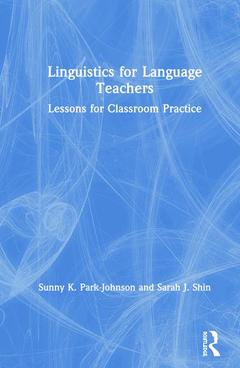Linguistics for Language Teachers Lessons for Classroom Practice
Auteurs : Park-Johnson Sunny, Shin Sarah J.

This book is an accessible introduction to linguistics specifically tailored for teachers of second language/bilingual education. It guides teachers stepwise through the components of language, focusing on the areas of linguistics that are most pertinent for teaching. Throughout the book there are opportunities to analyze linguistic data and discuss language-related issues in various educational and social contexts. Readers will be able to identify patterns in actual language use to inform their teaching and help learners advance to the next level. A highly readable account of how language works, this book is an ideal text for teacher education courses.
- Introduction
- Linguistics and Language Teachers
- Introduction
Table of Contents
List of tables
List of figures
Acknowledgements
Chapter 1: The Components of Language
1.3 The Layers
1.4 Linguistic competence
1.5 Myths and Truths About Human Language
1.6 Descriptive Linguistics
1.7 How to use this book
Chapter 2: Phonetics: The Sounds of Language
2.1 Introduction
2.2 Why do we need a phonetic alphabet?
2.3 Articulatory phonetics: How sounds are produced
2.4 Consonants
2.4.1 Places of Articulation
2.4.2 Manners of Articulation
2.5 Consonants in other languages
2.6 Vowels
2.6.1 Diphthongs
2.6.2 Phonics vs. Phonetics – What’s the difference?
2.7 Vowels in other languages
2.8 Suprasegmentals
2.8.1 Length
2.8.2 Stress
2.8.3 Pitch
2.9 Syllable-timed vs. Stress-timed languages
2.10 The importance of the [ə] in improving pronunciation in English
Recommended Websites
Further Reading
Exercises
References
Chapter 3: Phonology: The patterning of sounds
3.1 Introduction
3.2 What does it mean when we say we know a word?
3.3 Phonemes and Allophones
3.4 Natural Classes
3.4.1 Canadian Raising
3.4.2 Vowel Length in English
3.5 Phonological Processes
3.6 Syllables
3.7 How to help students improve their pronunciation in a second language
Further Reading
Exercises
References
Chapter 4: Morphology: The analysis of words
4.1 Introduction
4.1 Morphemes
4.2 Classifying Morphemes
4.3 Allomorphs
4.4 Inflection
4.5 Other Morphological Processes
4.6 Teaching Principles of Word Formation to Students
Recommended Websites
Further Readings
Exercises
References
Chapter 5: Syntax: The Analysis of Sentences
5.2 Constituency
5.3 Parts of speech
5.4 Phrase structure
5.5 Drawing Tree Diagrams
5.6 Clauses
5.7 Movement
5.8 Application to Teaching and Learning
Further Reading
Exercises
References
Chapter 6: Semantics and Pragmatics: The Study of Meanings
6.1 Introduction
6.2 Lexical Semantics
6.2.1 Sense and Reference
6.2.2 Word Relations
6.2.3 Homophony and Polysemy
6.3 Phrasal Semantics
6.4 Pragmatics
6.4.1 Context
6.4.2 Culture
6.4.3 Attitude and Perspective
6.4.4 Having Effective Conversation: Grice’s Maxims
6.4.5 Speech Acts
Exercises
References
Chapter 7: Language in Society
7.1 Introduction
7.2 Dialect
7.3 Language variation
7.3.1 Geography
7.3.2 Social Class
7.3.3 Gender
7.3.4 Age
7.4 Language and Identity
7.5 Language and Discrimination
7.6 Nonstandard Dialects
7.6.1 African American English
7.6.2 Chicano English
7.7 Incorporating Sociolinguistics in the Language Classroom
Further Reading
Exercises
References
Chapter 8: Languages in Contact
8.1 Introduction
8.2 Contact Situations
8.3 Borrowing
8.3.1 Lexical Borrowing
8.3.2 Structural Borrowing
8.4 Pidgins
8.5 Creoles
8.6 World Englishes
Exercises
References
Chapter 9: History of English
9.1 Introduction
9.2 Prehistory (to c. 450)
9.3 Old English (c. 450 – c. 1150)
9.4 Middle English (c. 1150 – c. 1450)
9.5 Modern English (c. 1450 – present)
9.6 The Great Vowel Shift
9.7 Northern Cities Chain Shift
Exercises
References
Chapter 10: Bilingualism and language policy
10.1 Introduction
10.2 Prevalence of Bilingualism in the World
10.3 Misconceptions about Bilingualism
10.4 Bilingual Education Programs
10.5 Helping Students Become Bilingual
Further Reading
Exercises
References
Chapter 11: Writing systems
11.1 Introduction
11.2 Written Versus Spoken Language
11.3 Writing Systems
11.3.1 Logographic Systems
11.3.2 Phonographic Systems
11.4 Learning to Read and Write
References
Exercises
Glossary
Index
Sunny K. Park-Johnson is an assistant professor in the College of Education at DePaul University. She received her Ph.D. in linguistics from Purdue University. Park-Johnson directs the Bilingual-Bicultural Education Minor and co-directs the Bilingual Language Development Lab. Her research interests include bilingual and heritage language development and maintenance, morphosyntax, and the intersection of theoretical linguistics, applied linguistics, and education.
Sarah J. Shin is Associate Provost for Academic Affairs at the University of Maryland Baltimore County, where she is also a professor of education. She received her Ph.D. in linguistics from the University of Michigan and specializes in bilingualism, heritage language education, and TESOL teacher preparation. Shin is the author of Bilingualism in schools and society (Routledge, 2018), English language teaching as a second career (Multilingual Matters, 2017), and Developing in two languages (Multilingual Matters, 2005).
Date de parution : 04-2020
15.2x22.9 cm
Date de parution : 04-2020
15.2x22.9 cm
Thème de Linguistics for Language Teachers :
Mots-clés :
Transitional Bilingual Education; Park-Johnson; Heritage Language Learners; language data; Mid Central Vowel; world language education; Adult ESL Teacher; bilingual; Northern Cities Chain Shift; teaching; Common Language; Shin; Past Tense; language teachers; Negative Concord; linguistics; Phrase Structure Rules; MAE; Asl; Great Vowel Shift; Lax Vowel; Phonographic Writing System; Immigrant Background Students; Vocal Fry; English Syllable Structure; Voiceless Consonant; Logographic Writing Systems; Voiceless Stops; Derivational Morphemes; Hard Palate; Language Teacher Candidates; Noun Phrase; Np



